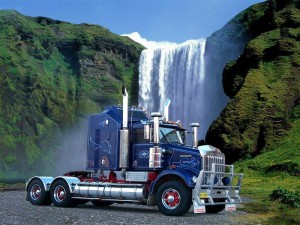The Washington State Department of Commerce issued a discussion paper about the state energy strategy entitled Commercial Vehicle and Fuel Technologies in June of 2011.
Summary: Commercial vehicles consume almost 40% of energy used in the US transportation in a wide variety of vehicles and configurations. Significant reductions in commercial transportation fuel consumption can be achieved with current and emerging technologies. Alternative fuels can replace petroleum, but technology, infrastructure cost, and feedstock availability challenges remain must be overcome. Shifting from planes and cars to rail can significantly reduce fuel use, but these shifts will require substantial long-term infrastructure investment.
 Medium and Heavy Duty Vehicles: This is the largest subcategory of the commercial vehicle group. It comprises 22% of the nation’s 2007 transportation energy use. Over the long term, significant reductions in fuel usage are possible. To be fully cost effective in several classes, the National Research Council (https://books.nap.edu/openbook.php?record_id=12845&page=108) estimates that fuel prices may have to be considerably higher than they are today. For tractor trailers to reduce fuel consumption by their estimated 51% potential, a breakeven fuel price of $1.10 would be required. Refuse trucks are estimated to be capable of reducing fuel consumption by 38% at a breakeven fuel price $2.70. Transit buses, however, can achieve a 48% reduction in fuel use, but at a breakeven fuel cost of $6.80.
Medium and Heavy Duty Vehicles: This is the largest subcategory of the commercial vehicle group. It comprises 22% of the nation’s 2007 transportation energy use. Over the long term, significant reductions in fuel usage are possible. To be fully cost effective in several classes, the National Research Council (https://books.nap.edu/openbook.php?record_id=12845&page=108) estimates that fuel prices may have to be considerably higher than they are today. For tractor trailers to reduce fuel consumption by their estimated 51% potential, a breakeven fuel price of $1.10 would be required. Refuse trucks are estimated to be capable of reducing fuel consumption by 38% at a breakeven fuel price $2.70. Transit buses, however, can achieve a 48% reduction in fuel use, but at a breakeven fuel cost of $6.80.
Aircraft: 10% of US transportation energy is used by commercial aircraft. Despite increased air travel, total energy used by commercial aircraft has not increased during the past decade as a result of more efficient aircraft and better management that has reduced per passenger mile fuel utilization. Engine efficiency, aerodynamic efficiency, better capacity utilization and increased aircraft size have reduced total fuel consumption since the 1970s. New composite aircraft such as the Boeing 787 are expected to further reduce fuel consumptions by 15-20%.
In addition, there is the opportunity to blend biofuels into conventional jet fuel. The Sustainable Aviation Fuels Northwest (SAFN) was formed to investigate and develop the use of biofuel in aircraft. Their report indicates that because commercial aircraft are normally fueled only at major airports and for a limited number of users, there will be opportunities to quickly develop a supply chain and encourage widespread usage of biofuels. Biojet is in early development and various feedstocks such as oilseeds, forest residues, solid wastes, and algae are all being considered. The Pacific Northwest has abundant stocks of such biomass, as well as the nation’s largest commercial aircraft manufacturer, and this may enable the region to be a biojet development leader.
Watercraft: Reductions in fuel utilization are also expected in this sector. Improvements in power system efficiency and management are expected to be the primary reasons. The Washington State Ferry System has explored the possibility of acquiring Liquefied Natural Gas (LNG) vehicles. These vehicles have been used in Norway and are reported to be well regarded. The challenges are higher initial cost, the need to develop new fuel infrastructure, and public acceptance.
Rail: Freight train fuel efficiency has increased by 80% in the last 25 years. Significant further improvements are possible: The US Department of Energy has set a goal of a 50% improvement between 2000 and 2025. This will require improved diesel engines and power control operations and the development of hybrid ele3ctric propulsion systems.